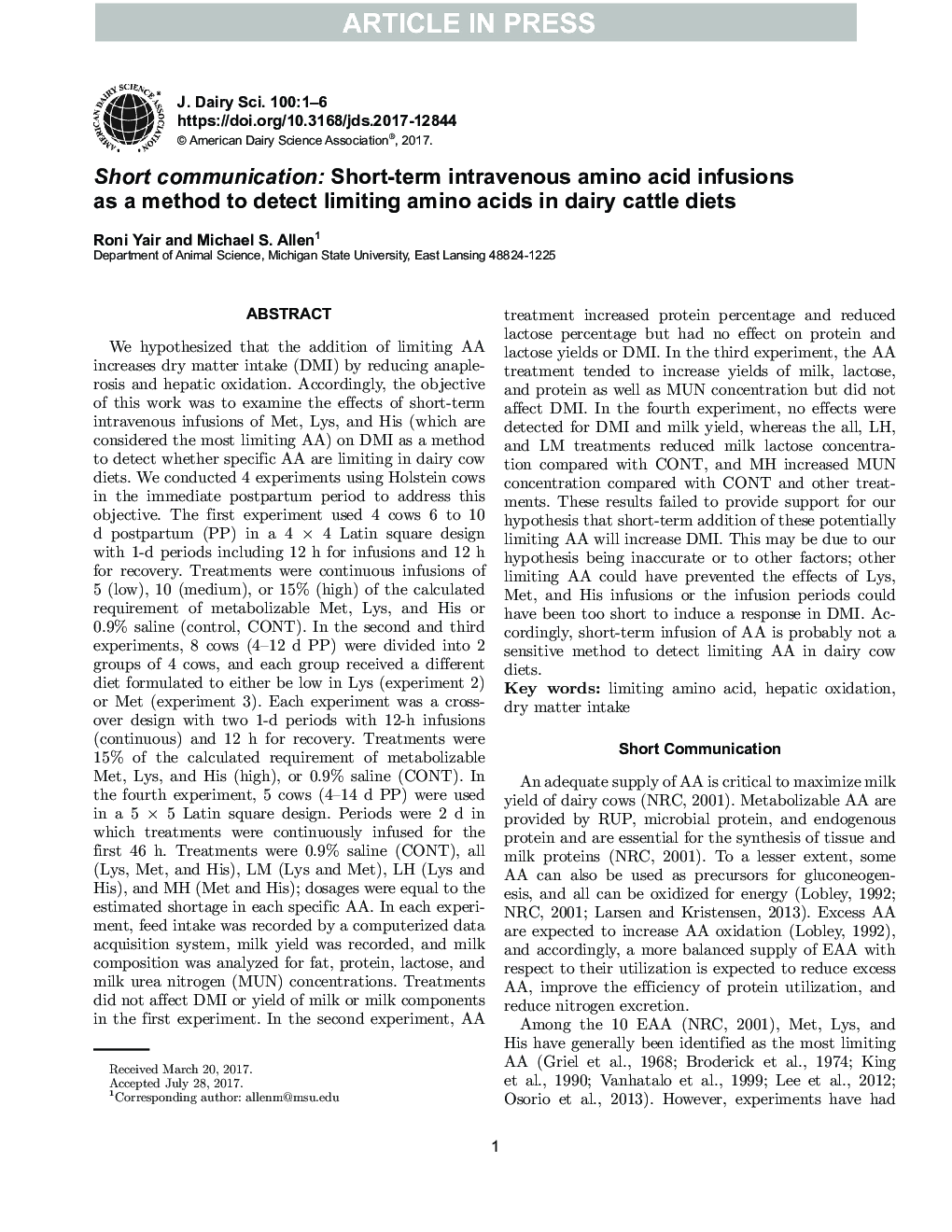| کد مقاله | کد نشریه | سال انتشار | مقاله انگلیسی | نسخه تمام متن |
|---|---|---|---|---|
| 5541671 | 1553846 | 2017 | 6 صفحه PDF | دانلود رایگان |
عنوان انگلیسی مقاله ISI
Short communication: Short-term intravenous amino acid infusions as a method to detect limiting amino acids in dairy cattle diets
ترجمه فارسی عنوان
ارتباط کوتاه: تزریق اسید آمینه اسید به مدت زمان کوتاه به عنوان یک روش برای تشخیص اسیدهای آمینه محدود در رژیم های گاو شیری
دانلود مقاله + سفارش ترجمه
دانلود مقاله ISI انگلیسی
رایگان برای ایرانیان
کلمات کلیدی
محدود کردن اسید آمینه اکسیداسیون کبدی، مصرف ماده خشک،
موضوعات مرتبط
علوم زیستی و بیوفناوری
علوم کشاورزی و بیولوژیک
علوم دامی و جانورشناسی
چکیده انگلیسی
We hypothesized that the addition of limiting AA increases dry matter intake (DMI) by reducing anaplerosis and hepatic oxidation. Accordingly, the objective of this work was to examine the effects of short-term intravenous infusions of Met, Lys, and His (which are considered the most limiting AA) on DMI as a method to detect whether specific AA are limiting in dairy cow diets. We conducted 4 experiments using Holstein cows in the immediate postpartum period to address this objective. The first experiment used 4 cows 6 to 10 d postpartum (PP) in a 4 Ã 4 Latin square design with 1-d periods including 12 h for infusions and 12 h for recovery. Treatments were continuous infusions of 5 (low), 10 (medium), or 15% (high) of the calculated requirement of metabolizable Met, Lys, and His or 0.9% saline (control, CONT). In the second and third experiments, 8 cows (4-12 d PP) were divided into 2 groups of 4 cows, and each group received a different diet formulated to either be low in Lys (experiment 2) or Met (experiment 3). Each experiment was a crossover design with two 1-d periods with 12-h infusions (continuous) and 12 h for recovery. Treatments were 15% of the calculated requirement of metabolizable Met, Lys, and His (high), or 0.9% saline (CONT). In the fourth experiment, 5 cows (4-14 d PP) were used in a 5 Ã 5 Latin square design. Periods were 2 d in which treatments were continuously infused for the first 46 h. Treatments were 0.9% saline (CONT), all (Lys, Met, and His), LM (Lys and Met), LH (Lys and His), and MH (Met and His); dosages were equal to the estimated shortage in each specific AA. In each experiment, feed intake was recorded by a computerized data acquisition system, milk yield was recorded, and milk composition was analyzed for fat, protein, lactose, and milk urea nitrogen (MUN) concentrations. Treatments did not affect DMI or yield of milk or milk components in the first experiment. In the second experiment, AA treatment increased protein percentage and reduced lactose percentage but had no effect on protein and lactose yields or DMI. In the third experiment, the AA treatment tended to increase yields of milk, lactose, and protein as well as MUN concentration but did not affect DMI. In the fourth experiment, no effects were detected for DMI and milk yield, whereas the all, LH, and LM treatments reduced milk lactose concentration compared with CONT, and MH increased MUN concentration compared with CONT and other treatments. These results failed to provide support for our hypothesis that short-term addition of these potentially limiting AA will increase DMI. This may be due to our hypothesis being inaccurate or to other factors; other limiting AA could have prevented the effects of Lys, Met, and His infusions or the infusion periods could have been too short to induce a response in DMI. Accordingly, short-term infusion of AA is probably not a sensitive method to detect limiting AA in dairy cow diets.
ناشر
Database: Elsevier - ScienceDirect (ساینس دایرکت)
Journal: Journal of Dairy Science - Volume 100, Issue 11, November 2017, Pages 9036-9041
Journal: Journal of Dairy Science - Volume 100, Issue 11, November 2017, Pages 9036-9041
نویسندگان
Roni Yair, Michael S. Allen,
